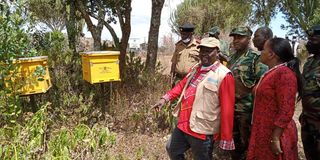Samburu pastoralists harness Kirisia forest bees as they aid conservation

Kenya's Chief Conservator of Forests (CCF) Julius Kamau inspects the apiculture project at Tamiyoi area in Kirisia forest, Samburu County
Giant cacti, umbrella-shaped shrubs, podo and other indigenous trees stretch out their branches as though they are frozen in a scramble.
Baboons, monkeys and warthogs roam up and down as we enter Tamiyoi, Samburu County. This area is part of the vast Kirisia forest, the largest water tower in northern Kenya.
Daniel Lenganyekie, one of the scouts mandated by Community Forest Association (CFS's) to safeguard the Kirisia forest ecosystem, prepares to harvest honey by gathering handfuls of dry lichen and lighting it to create a glowing bouquet for smoking out the bees.
A curious colobus monkey watched nearby as Mr Lenganyekie approached hives mounted near the Tamiyoi water spring. He inched towards the 200 yellowish hives clustered around the spring and blew smoke from his glowing embers into a tiny hole in the hive.
Within 10 minutes, he collects a bucketful of raw honey. "Stings are common but not as much," he says as he confirms being stung twice – in his shoulder and forearm.
Mr Lenganyekie then motions towards a small mobile tent.

Kenya's Chief Conservator of Forests (CCF) Julius Kamau inspects the apiculture project at Tamiyoi area in Kirisia forest, Samburu County
He is one of the scouts living in the tent to safeguard the water tower from encroachment.
While they safeguard the ecosystem, the forest scouts harness the potential of beekeeping in the vast forest.
While no meaningful economic activity can be practised in forests, the natural landscape and thick indigenous thicket in Kirisia is large and beekeeping thrives here.
The forest cover has more trees, which means more forage and food for the bees, and according to Mr Lenganyekie, this results in more honey harvests and therefore a financial incentive for maintaining the ecosystem.
Mr Lenganyekie and his colleagues considered honey production in the forest as a cash cow.
"We are generating income all along the honey chain. We felt we can generate cash as we continue to safeguard our forest here," Mr Lenganyekie told Nation.Africa.
He said demand for honey is high in and outside Samburu, something that is turning beekeeping into a lucrative deal. Increased demand, he said, brings income-generating opportunities to all scouts who keep bees in the Kirisia forest.
"With its many health and nutritional benefits, there is always a demand for honey, especially natural ones from the forest," he says.
Among Samburu pastoralists, besides being used as a food supplement, honey is also used to treat wounds as an anti-inflammatory. Locals also use it as a dietary antioxidant, instrumental in aiding digestive issues such as diarrhoea.
Even as they make money from beekeeping, their ambitions are not only profit-based. Their aim is to use beekeeping to reforest parts that have been degraded by pastoralism over the years.

Kenya's Chief Conservator of Forests (CCF) Julius Kamau receives five litres of natural honey from scouts in Tamiyoi area, within Kirisia forest, Samburu County
That is why the government, in collaboration with the United Nations Food and Agriculture Organisation (FAO), recently issued pastoralists around the forest with 200 beehives to help them engage in beekeeping activities while safeguarding the forest.
The agency is working with Samburu pastoralists to undertake beekeeping in the Kirisia forest as one of the ways to safeguard the ecosystem, said Hamisi Williams, FAO assistant representative to Kenya.
"We have so far issued hives to pastoralists and we will continue to work closely with the stakeholders to ensure that locals reap from this forest," Mr Hamisi said.
Naramat CFA chairman Douglas Leboiyare said they trained key pastoralists on how the beekeeping project would conserve the indigenous forest.
Beekeeping user groups – each consisting of pastoralists affiliated to the respective CFAs – were trained on how conserving indigenous trees can help sustain honey businesses, he said.
Besides beekeeping, Mr Leboiyare said user groups were also equipped with skills in nurturing indigenous trees on how to set up tree nurseries to support reforestation activities.
"They are reaping big from their sales and we help them find markets for their products. They are also using the knowledge and skills as local pastoralists to support livelihoods, boost the local economy and help conserve the wider Kirisia forest ecosystem," Mr Leboiyare said.
Beekeeping is a strategic management plan to restore the Kirisia forest, said Chief Conservator of Forests Julius Kamau. He said they have partnered with FAO in engaging locals to practise apiculture in the Kirisia forest to generate income while safeguarding the forest.
"We issued them with beehives and guided them on how to start apiculture. The forest is now fully restored. They (can reap) big from the natural insects," Mr Kamau added.
He said the government wants to protect forest covers.
Samburu County has a forest cover of 12 per cent, with three large forest areas that include Kirisia, Ndoto Ng’iro and Mathew Ranges.
It is said that the Kirisia forest, locally known as Leroghi, is two times bigger than the Maasai Mau forest. The ecosystem has more than 10 rivers, with indigenous trees such as sandalwood, red cedar, podo and a range of wildlife.





